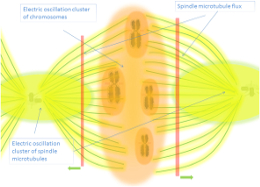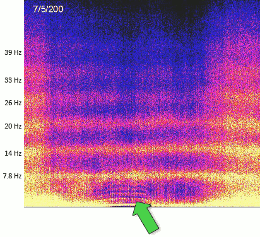

Light - Various
A variety of light wavelengths have different targets, pathways and therapeutic possibilities
Light interacts with biological systems in wavelength-specific ways, influencing processes such as nitric oxide modulation, ATP production, and tissue repair. Recent studies reveal light’s role in bioelectric signaling, coherence dynamics, and cellular communication. ...
This section synthesizes findings on the biological effects of various light wavelengths, their mechanisms of action, and their implications for systemic regulation and therapeutic applications.
Light, a fundamental component of life, profoundly influences biological systems. Beyond photosynthesis, light modulates cellular processes, signaling pathways, and systemic coherence through wavelength-specific interactions. From visible light to near-infrared (NIR) radiation, these effects are mediated by endogenous chromophores, bioelectric fields, and coherent energy transfer mechanisms. This section explores the diverse biological effects of light, highlighting experimental findings and their implications for health and therapy.
Mechanisms of Light-Mediated Biological Effects:
Chromophores and Absorption Spectra:
Key endogenous chromophores include flavins, porphyrins, and cytochromes, each with distinct absorption spectra (Plavskii et al., 2023).
For example, porphyrins contribute to singlet oxygen generation under 405 nm light, while flavins respond optimally to 445 nm light.
Nitric Oxide Modulation:
Light exposure modulates nitric oxide (NO) levels in cells through chromophore activation and NO release from mitochondrial binding sites (Pope et al., 2020).
Synergistic effects are observed with sequential blue and NIR light exposures, highlighting wavelength-dependent mechanisms.
Structured Water and Energy Transfer:
Infrared light interacts with structured water, enhancing charge separation and supporting ATP production (Korotkov, 2020).
Wavelength-Specific Biological Responses:
Visible and UV Light:
Blue light (415 nm) reduces ATP levels and inhibits proliferation in stem cells, while green light (540 nm) has variable effects on matrix mineralization (Wang et al., 2017).
UV light promotes differentiation and enhances cellular energy states, although excessive exposure risks oxidative damage.
Red and NIR Light:
Red (660 nm) and NIR (810 nm) light stimulate mitochondrial activity and ATP synthesis, supporting tissue repair and anti-inflammatory responses (Amaroli et al., 2018).
These wavelengths extend structured water domains, enhancing bioelectric conductivity and coherence.
Implications for Cellular and Systemic Regulation:
Cellular Communication:
Light influences bioelectric fields, aligning cellular activities and enhancing coherence within tissues (Pope et al., 2020).
Biophoton emissions mediated by light exposure facilitate intercellular signaling and energy transfer.
Systemic Coherence:
Light interacts with bioelectric networks, integrating circadian rhythms, energy metabolism, and adaptive responses.
Specific frequencies resonate with endogenous fields, modulating physiological functions at systemic levels.
Therapeutic Applications of Light:
Photobiomodulation:
Low-level laser therapy (LLLT) uses red and NIR light to promote wound healing, reduce inflammation, and manage chronic pain.
Blue and green light applications show promise in dermatology for managing conditions like psoriasis and promoting collagen synthesis.
Emerging Technologies:
Biophotonic gels, activated by light, generate emissions that stimulate tissue repair and cellular regeneration (Romanelli et al., 2017).
Innovations in transcranial light therapy target brain function, improving mood and cognitive performance.
Discussion: Light’s interaction with biological systems underscores its potential as a regulator of energy dynamics and systemic coherence. By activating chromophores and bioelectric networks, light mediates critical processes from cellular signaling to tissue regeneration. Future research should explore the interplay between light, structured water, and bioelectric fields to develop advanced therapeutic strategies.
Conclusion: Light’s biological effects extend beyond visible interactions to include profound influences on cellular energy states, coherence, and systemic regulation. These insights open pathways for innovative therapies that harness light’s potential to optimize health and treat complex conditions.
Keywords: light therapy, chromophores, nitric oxide modulation, photobiomodulation, structured water, systemic coherence, bioelectric signaling.
-Text generated by AI superficially, for more specific but also more surprising data check the tables below-Very related sections:
↑ text updated (AI generated): 28/12/2024
↓ tables updated (Human): 15/10/2025
Applied Fields - Experimental
 Light - Various
Light - Various
Various Experimentally applied lights ║ Various Therapeutically applied lights ║ Using wavelengths derived from Resonant Recognition Model ║ Reviews on Various Light wavelengths applied to Biosystems
|
|
|
|
|
| Author(s) |
|---|---|---|---|---|---|---|
| A |  | Endogenous Photoacceptors Sensitizing Photobiological Reactions in Somatic Cells | 405 nm, 445 nm |  | 2023-(1) | V. Y. Plavskii, L. G. Plavskaya, O. N. Dudinova, A. I. Tretyakova, A. V. Mikulich, A. N. Sobchuk, R. K. Nahorny, T. S. Ananich, A. D. Svechko, S. V. Yakimchuk, I. A. Leusenko |
| F |  | Wavelength- and irradiance-dependent changes in intracellular nitric oxide level (various targets) | 447 nm, 532 nm, 635 nm, 808 nm - 1.4-5.8 J/cm2 |  | 2020-(20) | Nathaniel J. Pope, Samantha M. Powell, Jeffrey C. Wigle, Michael L. Dentonc |
| A |  | Comparative Effect of Low-Intensity Laser Radiation in Green and Red Spectral Regions on Functional Characteristics of Sturgeon Sperm | 532 nm, 632 nm - (3 mW/cm2) |  | 2020-(1) | Vitaly Plavskii, Aliaksandr Mikulich, Nikolai Barulin, Tatsiana Ananich, Ludmila Plavskaya, Antonina Tretyakova, Ihar Leusenka |
| A |  | The Influence of Coherent Monochromatic and Non-monochromatic Electromagnetic Radiation on the Human Brain Rhythms | - |  | 2020-(1) | Iu. V. Ielchishcheva, V. P. Titar, O. V. Tyta, A. V. Melnikova |
| A |  | Polarized Polychromatic Noncoherent Light (Bioptron Light) as Adjunctive Treatment in Chronic Oral Mucosal Pain: A Pilot Study | 480–3400 nm - (40 mW/cm2) |  | 2019-(1) | Massimo Petruzzi, Gianna Maria Nardi, Fabio Cocco, Fedora della Vella, Roberta Grassi, Felice Roberto Grassi |
| A |  | Blue light effects in human keloid fibroblasts | - |  | 2019-(1) | Giada Magni, Federica Cherchi, Elisabetta Coppi, Marco Fraccalvieri, Francesca Tatini, Irene Fusco, Roberto Pini, Anna Maria Pugliese, Felicita Pedata, Antongiulio Mangia, Stefano Gasperini, Francesco Pavone, Duccio Rossi Degl'Innocenti, Cristina Tripodi, Domenico Alfieri, Lorenzo Targetti, Francesca Rossi |
| F |  | Photobiomodulation Affects Key Cellular Pathways of all Life‐Forms: Considerations on Old and New Laser Light Targets and the Calcium Issue | - |  | 2018-(5) | Andrea Amaroli, Sara Ferrando, Stefano Benedicenti |
| A |  | Wavelength dependence of intracellular nitric oxide levels in hTERT-RPE cells in vitro | 447-808 nm |  | 2018-(1) | Nathaniel J. Pope, Samantha M. Powell, Jeffrey C. Wigle |
| F |  | Transcranial bright light - The effect on human psychophysiology (ear canals) | 450-... nm |  | 2018-(92) | Heidi Jurvelin |
| A |  | Evaluation of fluorescence biomodulation in the real-life management of chronic wounds: the EUREKA trial (fluorescence or biophoton) | - |  | 2018-(1) | Marco Romanelli, Alberto Piaggesi, Giovanni Scapagnini, Valentina Dini, Agata Janowska, Elisabetta Iacopi, Carlotta Scarpa, Stéphane Fauverghe, Franco Bassetto |
| F |  | EUREKA study - the evaluation of real-life use of a biophotonic system in chronic wound management: an interim analysis (fluorescence or biophoton) | 500-610 nm |  | 2017-(8) | Marco Romanelli, Alberto Piaggesi, Giovanni Scapagnini, Valentina Dini, Agata Janowska, Elisabetta Iacopi, Carlotta Scarpa, Stéphane Fauverghe, Franco Bassetto |
| F |  | Red (660 nm) or near-infrared (810 nm) photobiomodulation stimulates, while blue (415 nm), green (540 nm) light inhibits proliferation in human adipose-derived stem cells | 415-810 nm - (15 mW/cm2) |  | 2017-(10) | Yuguang Wang, Ying-Ying Huang, Yong Wang, Peijun Lyu, Michael R. Hamblin |
| F |  | Oocyte maturation under a biophoton generator improves preimplantation development of pig embryos derived by parthenogenesis and somatic cell nuclear transfer | - |  | 2017-(7) | Joohyeong Lee, Hyeji Shin, Wonyou Lee, Seung Tae Lee, Geun-Shik Lee, Sang-Hwan Hyun, Eunsong Le |
| F |  | Transcranial Light Alters Melanopsin and Monoamine Production in Mouse (Mus musculus) Brain (ear canals) | 450 nm - (<14.7 mW/cm2) |  | 2017-(7) | Antti Flyktman, Toni Jernfors, Satu Manttari, Juuso Nissila, Markku Timonen, Seppo Saarela |
| F |  | Direct detection of a single photon by humans | - |  | 2016-(9) | Jonathan N. Tinsley, Maxim I. Molodtsov, Robert Prevedel, David Wartmann, Jofre Espigulé-Pons, Mattias Lauwers, Alipasha Vaziri |
| F |  | Human Brain Reacts to Transcranial Extraocular Light (ear canals) | 448 nm |  | 2016-(12) | Lihua Sun, Jari Peräkylä, Anselmi Kovalainen, Keith H. Ogawa, Pekka J. Karhunen, Kaisa M. Hartikainen |
| A |  | Green laser light irradiation enhances differentiation and matrix mineralization of osteogenic cells | 532 nm - 4 J/cm2 |  | 2016-(1) | Elisabetta Merigo, Sebastien Bouvet-Gerbettaz, Florian Boukhechba, Jean-Paul Rocca, Carlo Fornaini, Nathalie Rochet |
| F |  | LORETA indicates frequency-specific suppressions of current sources within the cerebrums of blindfolded subjects from patterns of blue light flashes applied over the skull (transcranial) | 470 nm - 10000 lux |  | 2015-(6) | Lukasz M. Karbowski, Kevin S. Saroka, Nirosha J. Murugan, Michael A. Persinger |
| F |  | Transcranial light affects plasma monoamine levels and expression of brain encephalopsin in the mouse (ear canals) | 450 nm - (<14.7 mW/cm2) |  | 2015-(7) | Antti Flyktman, Satu Mänttäri, Juuso Nissilä, Markku Timonen, Seppo Saarela |
| F |  | Transcranial bright light exposure via ear canals does not suppress nocturnal melatonin in healthy adults – A single-blind, sham-controlled, crossover trial (ear canals) | 450 nm - (7.28 mW/cm2) |  | 2014-(6) | Heidi Jurvelin, Timo Takala, Lilli Heberg, Juuso Nissila, Melanie Ruger, Juhani Leppaluoto, Seppo Saarela, Olli Vakkuri |
| F |  | Emerging Evidence on the Crystalline Water-Light Interface in Ophthalmology and Therapeutic Implications in Photobiomodulation: First Communication (water) | 305-400 nm - (0.05 mW/cm2) |  | 2014-(2) | Elizabeth Rodríguez-Santana, Luis Santana-Blank |
| F |  | Bright light transmits through the brain: Measurement of photon emissions and frequency-dependent modulation of spectral electroencephalographic power (transcranial) | 10000 lux |  | 2013-(7) | Michael A. Persinger, Blake T. Dotta, Kevin S. Saroka |
| F |  | Effect of Polarization and Coherence of Optical Radiation on Sturgeon Sperm Motility | 420-800 nm, 670 nm - (1.5 mW/cm2) |  | 2012-(5) | Nikolai V. Barulin, Vitaly Yu. Plavskii |
| F |  | The effect of biophoton intervention on the pH level of aging milk [thesis] | - |  | 2010-(59) | Paul Mak |
| F |  | Effect of Radiant Energy on Near-Surface Water (water) | 250-650 nm, 1750-4250 nm |  | 2009-(13) | Binghua Chai , Hyok Yoo , Gerald H. Pollack |
|
|
|
|
|
| Author(s) |
|---|---|---|---|---|---|---|
| F |  | Modulating depressive-like behaviors, memory impairment, and oxidative stress in chronic stress rat model using visible light therapy | 460-650 nm |  | 2025-(18) | Elham Zahedi, Rasoul Kavyannejad, Pooria Salami, Seyed Shahabeddin Sadr |
| F |  | Can the Low-level Laser Therapy Benefits the Conventional Treatment to the Bell’s Palsy? Report of a Successful Case | - |  | 2025-(9) | Fernanda Pires do Nascimento, Larissa Leci Fernandes, Thais Massetti, Ângela Toshie Araki, Cristiane de Almeida Baldini, Tatiane Fernandes Novaes |
| F |  | Green Light Exposure Elicits Anti-inflammation, Endogenous Opioid Release and Dampens Synaptic Potentiation to Relieve Post-surgical Pain | 525 nm - (0.014 mW/cm2) |  | 2023-(21) | Laurent F. Martin, Kevin Cheng, Stephanie M. Washington, Millie Denton, Vasudha Goel, Maithili Khandekar, Tally M. Largent-Milnes, Amol Patwardhan, Mohab M. Ibrahim |
| F |  | Energetic homeostasis achieved through biophoton energy and accompanying medication treatment resulted in sustained levels of Thyroiditis-Hashimoto's, iron, vitamin D & vitamin B12 | - |  | 2023-(10) | Mariola A. Smotrys, James Z. Liu, Suzanne Street, Seth Robinson |
| F |  | In vitro investigation of the antibacterial and anti-inflammatory effects of LED irradiation | 470-850 nm - 10 J/cm2 |  | 2022-(10) | Jungwon Lee, Hyun-Yong Song, Sun-Hee Ahn, Woosub Song, Yang-Jo Seol, Yong-Moo Lee, Ki-Tae Koo |
| F |  | Experimental Study on Blue Light Interaction with Human Keloid-Derived Fibroblasts | 410-430 nm - 0.69 J/cm2 (3.4-41.2 mW/cm2) |  | 2020-(19) | Giada Magni, Martina Banchelli, Federica Cherchi, Elisabetta Coppi, Marco Fraccalvieri, Michele Rossi, Francesca Tatini, Anna Maria Pugliese, Duccio Rossi Degl’Innocenti, Domenico Alfieri, Paolo Matteini, Roberto Pini, Francesco S. Pavone, Francesca Rossi |
| F |  | A double-masked, randomized, sham-controlled, single-center study with photobiomodulation for the treatment of dry age-related macular degeneration | 590 nm + 660 nm + 850 nm |  | 2020-(12) | Samuel N. Markowitz, Robert G. Devenyi, Marion R. Munk, Cindy L. Croissant, Stephanie E Tedford, Rene Rückert, Michael G. Walker, Beatriz E. Patino, Lina Chen, Monica Nido, Clark E. Tedford |
| F |  | Effects of green light photobiomodulation on Dental Pulp Stem Cells: enhanced proliferation and improved wound healing by cytoskeleton reorganization and cell softening | 532 nm - 5 J/cm2 |  | 2020-(9) | Eve Malthiery, Batoul Chouai, Ana María Hernandez-Lopez, Marta Martin, Csilla Gergely, Jacques-Henri Torres, Frédéric J. Cuisinier, Pierre-Yves Collart-Dutilleu |
| F |  | Twelve months follow-up comparison between the autistic children vs. initial placebo (treated) groups | - |  | 2019-(22) | Calixto Machado, Machado Yanin, Mauricio Chinchilla, Yazmina Machado |
| A |  | Blue light therapy to treat candida vaginitis with comparisons of three wavelengths: an in vitro study | 405 nm, 415 nm, 450 nm - (50 mW/cm2) |  | 2020-. (1) | Tianfeng Wang, Jianfei Dong, Huancai Yin, Guoqi Zhang |
| A |  | Biomodulation induced by fluorescent light energy versus standard of care in venous leg ulcers: a retrospective study | - |  | 2019-(1) | Valentina Dini, Agata Janowska, Giulia Davini, Jean-Charles Kerihuel, Stéphane Fauverghe, Marco Romanelli |
| F |  | The impact of wavelengths of LED light-therapy on endothelial cells | 475-635 nm - (40 mW/cm2) |  | 2018-(11) | Sabrina Rohringer, Wolfgang Holnthoner, Sidrah Chaudary, Paul Slezak, Eleni Priglinger, Martin Strassl, Karoline Pill, Severin Mühleder, Heinz Redl, Peter Dunge |
| F |  | Red (635 nm), Near-Infrared (808 nm) and Violet-Blue (405 nm) Photobiomodulation Potentiality on Human Osteoblasts and Mesenchymal Stromal Cells: A Morphological and Molecular In Vitro Study | 405-808 nm - 0.4 J/cm2 |  | 2018-(23) | Alessia Tani, Flaminia Chellini, Marco Giannelli, Daniele Nosi, Sandra Zecchi-Orlandini, Chiara Sassoli |
| A |  | Differential response of human dermal fibroblast subpopulations to visible and near-infrared light: Potential of photobiomodulation for addressing cutaneous conditions | 450-850 nm |  | 2018-(1) | Charles Mignon, Natallia E. Uzunbajakava, Irene Castellano‐Pellicena, Natalia V. Botchkareva, Desmond J. Tobin |
| F |  | Effect of visible range electromagnetic radiation on Escherichia Coli | 464-644 nm |  | 2017-(8) | Samina T. Yousuf Azeemi, Saleem Farooq Shaukat, Khawaja Shamsuddin Azeemi, Idrees Khan, Khalid Mahmood, Farah Naz |
| F |  | Effects of light emitting diode irradiation on neural differentiation of human umbilical cord-derived mesenchymal cells | 530-630 nm - (5.3 mW/cm2) 0.31-1.59 J/cm2 |  | 2017-(9) | Samereh Dehghani-Soltani, Mohammad Shojaee, Mahshid Jalalkamali, Abdolreza Babaee, Seyed Noureddin Nematollahi-Mahani |
| A |  | Low level lasers effect on proliferation, migration and anti-apoptosis of mesenchymal stem cells | - |  | 2017-(1) | Kan Yin, Rongjia Zhu, Shihua Wang, Robert Chunhua Zhao |
| F |  | Neuroprotective Effects Against POCD bt Photobiomodulation Evidence from Assembly/Disassembly of the Cytoskeleton | - |  | 2015-(19) | Ann D. Liebert , Roberta T. Cho, Brian t. Bicknell, Euahna Varigos |
| F |  | Promotion of neural sprouting using low-level green light-emitting diode phototherapy | 520 nm - (100mW/cm2) |  | 2015-(3) | Noa Alon, Hamootal Duadi, Ortal Cohen, Tamar Samet, Neta Zilony, Hadas Schori, Orit Shefi, Zeev Zalevsky |
| F |  | Different effects of energy dependent irradiation of red and green lights on proliferation of human umbilical cord matrix-derived mesenchymal cell | 532 nm, 630 nm - 0.31-12.72 J/cm2 |  | 2015-(7) | Samereh Dehghani Soltani, Abdolreza Babaee, Mohammad Shojaei, Parvin Salehinejad, Fatemeh Seyedi, Mahshid JalalKamali, Seyed Noureddin Nematollahi-Mahani |
| A |  | Low level light therapy by LED of different wavelength induces angiogenesis and improves ischemic wound healing | 470nm, 629nm - (50 mW/cm2) |  | 2014-(1) | P. Dungel, J. Hartinger, S. Chaudary, P. Slezak, A. Hofmann, T. Hausner, M. Strassl, E. Wintner, H. Redl, R. Mittermayr |
| F |  | Transcranial bright light treatment via the ear canals in seasonal affective disorder: a randomized, double-blind dose-response study (ear canals) | 448 nm - 2386 lux (0.72 mW/cm2), 9542 lux (2.88 mW/cm2), 21470 lux (6.48 mW/cm2) |  | 2014-(11) | Heidi Jurvelin, Timo Takala, Juuso Nissilä, Markku Timonen, Melanie Rüger, Jari Jokelainen, Pirkko Räsänen |
| F |  | Biophotonic energy in an intratubal insemination program | - |  | 2013-(4) | G.Menaldo, S.Serrano, S.Benvenuto, B.Lopez |
| A |  | Green light emitting diodes accelerate wound healing: Characterization of the effect and its molecular basis in vitro and in vivo | 456 nm, 518 nm, 456 nm |  | 2012-(1) | |
| A |  | Effect of LED phototherapy of three distinct wavelengths on fibroblasts on wound healing: a histological study in a rodent model | 460nm, 530nm, 700nm - 10 J/cm2 |  | 2010-(1) | A.P.C. de Sousa, J.N. Santos, J.A. dos Reis Jr, T.A. Ramos, J. de Souza, M.C.T. Cangussú, A.L. Pinheiro |
.
.




















